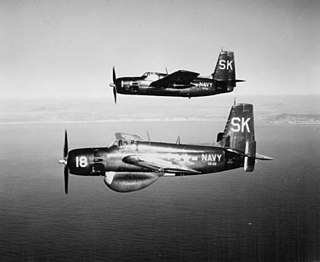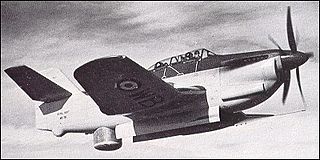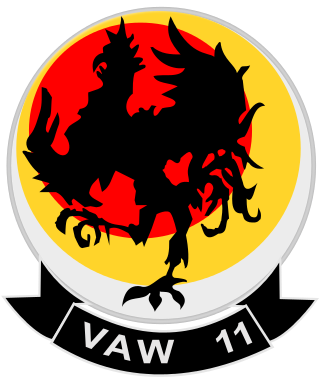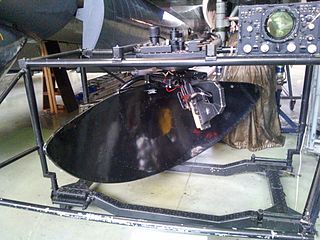See also
Aircraft of comparable role, configuration, and era
| XS2U | |
|---|---|
| Role | Anti-submarine warfare aircraft |
| National origin | United States |
| Manufacturer | Chance Vought Aircraft |
| Status | Canceled project |
| Number built | 0 |
The Vought XS2U was a design for an all-weather, carrier-based anti-submarine warfare (ASW) aircraft. A twin-engine, twin-tailed, mid-wing, propeller-driven design with tricycle landing gear, it lost to the Grumman S2F Tracker in the United States Navy competition, and the two prototypes were not completed.
Chance Vought Aircraft began work on 25 January 1950 on a U.S. Navy proposal for an all-weather anti-submarine warfare design. The company constructed a full-scale mock-up of the XS2U-1 and received a contract-of-intent for two XS2U-1 prototypes, BuNos 133780 and 133781, which were not completed before development was abandoned. [1]
Three-blade propellers similar to those used on the S2F were installed on the mock-up, which had a two-wheel nosegear, and single-tire main gear that would retract into the engine nacelles. The twin-tail fins were canted inward, 90 degrees from the tailplane dihedral.
Construction was begun on the fuselages and wings, but technical difficulties arose over how to fold the wings for carrier stowage. A complicated double-fold of each wing outboard of the radial engine was required. The contract was canceled and neither airframe was completed, the Navy electing to acquire the S2F Tracker instead.
The S2U was also proposed for the carrier-borne AEW role as the S2U-1W, later changed to WU-1. [2] A bulged radome was astride the center fuselage, and the forward fuselage/cockpit design bore a passing resemblance to the later Grumman Mohawk.
Aircraft of comparable role, configuration, and era

The Northrop Grumman E-2 Hawkeye is an American all-weather, carrier-capable tactical airborne early warning (AEW) aircraft. This twin-turboprop aircraft was designed and developed during the late 1950s and early 1960s by the Grumman Aircraft Company for the United States Navy as a replacement for the earlier, piston-engined E-1 Tracer, which was rapidly becoming obsolete. The aircraft's performance has been upgraded with the E-2B and E-2C versions, where most of the changes were made to the radar and radio communications due to advances in electronic integrated circuits and other electronics. The fourth major version of the Hawkeye is the E-2D, which first flew in 2007. The E-2 was the first aircraft designed specifically for AEW, as opposed to a modification of an existing airframe, such as the Boeing E-3 Sentry. Variants of the Hawkeye have been in continuous production since 1960, giving it the longest production run of any carrier-based aircraft.

The Grumman S-2 Tracker was the first purpose-built, single airframe anti-submarine warfare (ASW) aircraft to enter service with the United States Navy. Designed and initially built by Grumman, the Tracker was of conventional design — propeller-driven with twin radial engines, a high wing that could be folded for storage on aircraft carriers, and tricycle undercarriage. The type was exported to a number of navies around the world. Introduced in 1952, the Tracker and its E-1 Tracer derivative saw service in the U.S. Navy until the mid-1970s, and its C-1 Trader derivative until the mid-1980s, with a few aircraft remaining in service with other air arms into the 21st century. Argentina and Brazil are the last countries to still use the Tracker.

The Grumman E-1 Tracer was the first purpose-built airborne early warning aircraft used by the United States Navy. It was a derivative of the Grumman C-1 Trader and entered service in 1958. It was replaced by the more modern Grumman E-2 Hawkeye by the 1970s.

The Grumman C-1 Trader is a carrier onboard delivery (COD) variant of the Grumman S-2 Tracker. It was replaced by a similar version of the Northrop Grumman E-2 Hawkeye, the Grumman C-2 Greyhound.

The Grumman F7F Tigercat is a heavy fighter aircraft that served with the United States Navy (USN) and United States Marine Corps (USMC) from late in World War II until 1954. It was the first twin-engine fighter to be deployed by the USN. While the Tigercat was delivered too late to see combat in World War II, it saw action as a night fighter and attack aircraft during the Korean War.

The Fairey Gannet is a carrier-borne aircraft that was designed and produced by the British aircraft manufacturer the Fairey Aviation Company. It was developed for the Royal Navy, being the first fixed-wing aircraft to combine both the search and strike portions of anti-submarine warfare (ASW) operations to be operated by the Fleet Air Arm (FAA).

The Vought SB2U Vindicator is an American carrier-based dive bomber developed for the United States Navy in the 1930s, the first monoplane in this role. Vindicators still remained in service at the time of the Battle of Midway, but by 1943, all had been withdrawn to training units. It was known as the Chesapeake in Royal Navy service.
The Yakovlev Yak-44 was a proposed twin-turboprop Airborne Early Warning (AEW) aircraft, resembling the United States Navy's E-2 Hawkeye, intended for use with the Soviet Navy's Ulyanovsk class supercarriers. Along with the aircraft carrier it would have flown from, the Yak-44 was cancelled after the demise of the Soviet Union. A full-scale mockup with foldable wings was built.

The Grumman F3F is a biplane fighter aircraft produced by the Grumman aircraft for the United States Navy during the mid-1930s. Designed as an improvement on the F2F, it entered service in 1936 as the last biplane to be delivered to any American military air arm. It was retired from front line squadrons at the end of 1941 before it could serve in World War II, and replaced by the Brewster F2A Buffalo. The F3F, which inherited the Leroy Grumman-designed retractable main landing gear configuration first used on the Grumman FF, served as the basis for a biplane design ultimately developed into the much more successful F4F Wildcat that succeeded the subpar Buffalo.

The Grumman XF5F Skyrocket was a prototype twin-engined shipboard fighter interceptor. The United States Navy ordered one prototype, model number G-34, from Grumman Aircraft Engineering Corporation on 30 June 1938; its designation was XF5F-1. The aircraft had a unique appearance: The forward "nose" of the fuselage did not extend forward of the wing. Provisions were included for two 20 mm (0.787 in) Madsen cannon as armament.

The Grumman AF Guardian is the first purpose-built anti-submarine warfare (ASW) carrier-based aircraft to enter service with the United States Navy. It consisted of two airframe variants, one for detection gear, the other for weapons. The Guardian remained in service until August 1955, when it was replaced by the twin-engined Grumman S-2 Tracker. The Guardian was the largest single-engine piston-powered carrier aircraft ever to see service.

The Grumman XTSF was a proposed twin-engine torpedo scout aircraft, designed by Grumman for the United States Navy towards the end of World War II. Based on the design of the Grumman F7F Tigercat fighter, but enlarged and with the addition of a bomb bay, the XTSF was deemed too large for carrier operations, and the project was cancelled before any aircraft were built. Instead, the Navy chose to order the single-engine XTB3F, which became the successful AF Guardian.

The Blackburn B-54 and B-88 were prototype carrier-borne anti-submarine warfare aircraft of the immediate post-Second World War era developed for the Royal Navy's Fleet Air Arm (FAA). They shared a conventional monoplane design with a mid-mounted inverted-gull wing and tricycle undercarriage. The pilot and observer sat in tandem under a long canopy atop the fuselage. The B-54 had a piston engine while the B-88 had a gas turbine driving large contra-rotating propellers. The radar scanner was mounted in a retractable radome in the rear fuselage, behind a long internal weapons bay. The program was cancelled in favour of the Fairey Gannet aircraft.

The Short Sturgeon was a planned British carrier-borne reconnaissance bomber whose development began during Second World War with the S.6/43 requirement for a high-performance torpedo bomber, which was later refined into the S.11/43 requirement which was won by the Sturgeon. With the end of the war in the Pacific production of the aircraft carriers from which the Sturgeon was intended to operate was suspended and the original reconnaissance bomber specification was cancelled.

The Grumman XSBF, also known by the company designation G-14, was an American biplane scout bomber developed by Grumman Aircraft for the United States Navy during the 1930s. Derived from Grumman's successful "Fifi" fighter, the aircraft was developed at a time when the biplane was giving way to the monoplane. In competition against other aircraft it proved to possess inferior performance in its intended role, and did not enter production. The sole prototype went on to serve as a liaison aircraft, as well as being used in experiments by NACA, before being destroyed in a crash in 1939.

The Fairey Gannet AEW.3 is a variant of the Fairey Gannet anti-submarine warfare aircraft intended to be used in the airborne early warning (AEW) role on aircraft carriers of the Royal Navy. It was introduced to service in 1959 to replace the obsolete Douglas Skyraider, and was intended as an interim solution until the planned introduction of a new, purpose built AEW platform for use on the planned CVA-01 aircraft carriers. Neither the new aircraft carriers nor the new AEW aircraft were proceeded with, and the Gannet AEW.3 remained in service until the last aircraft carrier that could operate it was retired in 1978.

Carrier Airborne Early Warning Squadron 11 (VAW-11), nicknamed the "Early Elevens", was an airborne early warning squadron, whose mission was to provide services to fleet forces and shore warning networks, under all weather conditions. The squadron was also responsible for combat air patrol and Anti-submarine warfare (ASW) missions. It was based at NAS North Island in San Diego, California, but had detachments serving aboard 13 attack carriers and antisubmarine carriers in the Pacific Fleet.
The Xi'an KJ-600 is a Chinese twin-propeller, quad-tail, high-wing military aircraft designed for cargo and airborne early warning and control (AEW&C), intended to be deployed on Type 003 aircraft carriers and maybe the Type 004 aircraft carriers of the People's Liberation Army Navy from around 2024.

The AN/APS-20 was an airborne early warning, anti-submarine, maritime surveillance and weather radar developed in the United States in the 1940s. Entering service in 1945, it served for nearly half a century, finally being retired in 1991. Initially developed at Massachusetts Institute of Technology (MIT) under Project Cadillac, the radar was developed to be carried by aircraft to extend the sensor range of ships by placing a radar at altitude. Although developed for carrier-borne operation, first being installed in the single-engined General Motors TBM-3W Avenger, it was also used in larger four-engined airframes, the last being a fleet of Avro Shackleton AEW.2 which were converted from maritime patrol aircraft. Similarly, although developed for detecting aircraft, it saw extensive service in anti-submarine and maritime patrol roles and was one of the first radars to be used in researching extreme weather like hurricanes by agencies like the Environmental Science Services Administration (ESSA). As well as the United States, the radar was used by a large number of services in other countries, including the French Navy, Japan Maritime Self-Defense Force (JMSDF), Royal Air Force (RAF) and Royal Canadian Air Force (RCAF). Early versions of the radar could see a low-flying aircraft at 65 nautical miles and a ship at 200 nautical miles. This was improved, so that later versions had a range against aerial targets of 115 nautical miles.